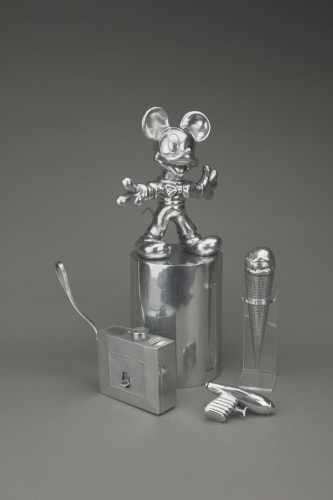In the 1990s Clive Barker (b. 1940), known for his typical love of disguising reality and play on contrasts, renewed his successful career as a Pop artist. At that time, Barker chose to work solely with aluminium, using the technique of sand casting. Fast, easy and low-cost, sand casting appealed after Minimalism and Post-Pop had forced Pop Art from the centre stage during the 1980s.
During the first two decades of his career, 1961-1981, Barker had played with the element of ambiguity, a quintessential practice of the Surrealists. Where one of his American Pop colleagues, Claes Oldenburg, reinvented sculpture in the early 1960s by taking 'hard' manufactured objects from the contemporary environment and rendering them as 'soft' forms sewn from canvas, Barker had often turned forms that are pliable or tender to the touch into inflexible metal objects that convey an indisputable sense of their permanence. By casting found objects in bronze, he turned the ephemeral into the eternal and as such positioned himself as an heir to Marcel Duchamp by occasionally employing the core ideas of Conceptual Art.
Barker exhibited with the legendary ‘Groovy Bob’ Robert Fraser, Erica Brausen of the Hanover Gallery and with Anthony d’Offay. Barker was an essential part of Swinging London, where art, fashion and pop music fused and lead to the creation of Pop Culture, a movement which strived for real emancipation of the masses. During the 1960s, Barker was able to spend time in New York with his friends Jim Dine and Roy Lichtenstein. His work entered numerous museum collections and prominent Pop Art collections world-wide. During 1980-81, Barker’s work was the subject of a retrospective exhibition at the Sheffield City Art Gallery, touring Stoke, Eastbourne and Cheltenham.
Barker’s return to the art market with these aluminium sand casts, illustrates his artistic resolve. The aluminium objects demonstrate a steadfast link with the past when Barker established his unique style of sculpture and show once more an artist with great talent to surprise, reinvent and disguise the found object. In contrast with Barker’s early work, the 1990’s sand casts were often produced in editions and are therefore easily accessible.
Museums holding Barker's work include: The Arts Council Collection; British Council; Tate, London; British Museum, London; Imperial War Museum, London; Victoria and Albert Museum, London; Aberdeen Art Gallery, Aberdeen; Graves Art Gallery, Sheffield; Staedtische Kunsthalle, Mannheim; Museum fuer Moderne Kunst, Frankfurt; Museum of South Australia, Adelaide; The National Museum of Contemporary Art, Lisbon; The Hirshhorn Museum and Sculpture Garden, Washington DC; Philadelphia Museum of Art, Philadelphia.

